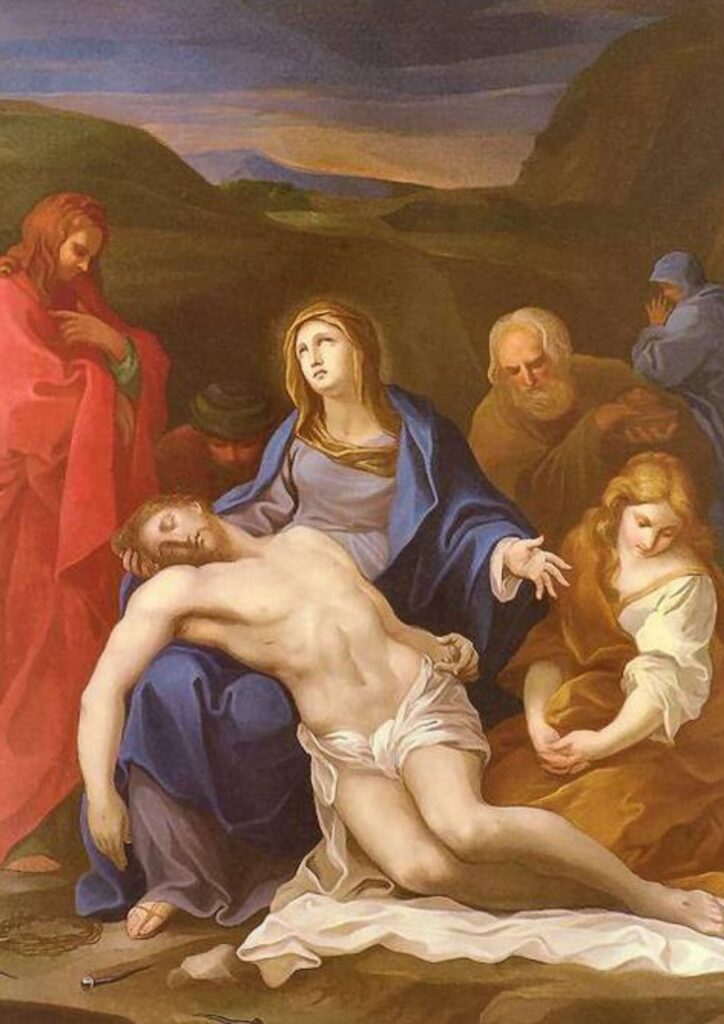Theology has shown us that Mary’s compassion participated in our salvation as merit, as satisfaction, and as sacrifice, in the image of the Passion of Christ. The last characteristic is: redemption, or more precisely when applied to Mary, co-redemption.
The teachings of the popes
Leo XIII, in the encyclical Adjutricem populi: calls Mary the “Reparatrix of the whole world.”
Benedict XV in the Brief Inter sodalicia:
“To such extent did Mary suffer and almost die with her suffering and dying Son; to such extent did she surrender her maternal rights over her Son for man’s salvation, and immolated Him—insofar as she could—in order to appease the justice of God, that we rightly say she redeemed the human race together with Christ.”
Pius XI, Allocution of November 30, 1933: “From the nature of His work the Redeemer ought to have associated His Mother with His work. For this reason We invoke her under the title of Coredemptrix.”
Theological reasons
It is appropriate for a woman to participate in the Redemption since a woman participated in the fall. The fall is the work of all men and God made the raising be the work of all men.
1) The Redemption metaphorically shows the work of the salvation of men by a double connection:
–From the point of view of the effects: they are compared to a liberation from servitude to the devil, from sin, and from the punishment incurred because of sin.
–From the point of view of the action accomplished to obtain these effects: it is compared to a purchase, where the purchaser offers his own property against the goods he desires. He is only a purchaser:
*if he himself makes the exchange;
*if the part that he brings is his own.
This is the case with Jesus Christ who Himself paid the price, and this price is His Blood. For these reasons, it properly belongs to Christ to be the Redemptor.
2) To speak of co-redemption is to designate a participation in this work. Regarding the Mother of God, we can grasp her manner of participation in the Redemption by comparing her role to that of Christ:
–Regarding the effects: Our Lady obtains from appropriateness [de congruo] what Jesus obtains in justice [de condigno]. The same effects are produced, but with a subordinate, though universal, efficacy.
–Regarding the action that produces these effects, compared to a purchase:
*Christ alone offers the sacrifice of His Blood as priest, but Our Lady unites herself with this intention after having furnished the victim.
*The price offered properly belongs to Christ, but it is something of Mary, for three reasons:
–The principal price, the Precious Blood, was produced from Mary’s substance.
–Her acceptance (the Fiat) is the sine qua non condition of this redemption.
–Among the sorrows of the Passion, some only exist because the Savior has an associate.
“The presence of and the suffering of Mary gives to the Passion of Christ a quality that would have been missing. Mary’s suffering would have been missing in a Redemption that wanted to be the offering to God of all human suffering. Jesus could suffer anything except that compassion towards His own sufferings. Everything that tears apart two beings who love one another, and the sorrow of one resounding in the other, is what Mary’s presence is with Jesus in His redemptive sacrifice, and enabled her to live in our name.” Nicolas, Theotokos.
3) The special place of the new Eve in the Redemption appears more clearly if we compare it to the participation of the other just ones in the Redemption:
–As to the effects:
*The merits of the just have a particular efficacy, whereas Our Lady’s have a universal efficacy.
*In addition, the just only obtain the application of the merits of the Passion, whereas the Virgin participates in their very acquisition.
–As to the Redemptive act:
*Like Mary, the faithful can unite their intention to it, but with a lesser charity.
*Although Jesus has a human nature, the faithful cannot lay claim to the price offered as being theirs, at least as much as the Mother of Jesus. They can only offer their own efforts in union with the Cross. Our Lady does so as well, with greater perfection.
Conclusion
The Redemption happened thus in three stages, in which the Son of God intervened as the principal agent and His Mother in a secondary manner:
- The Incarnation, which established the Mediator, God and man. Our Lady acted according to the grace of her divine maternity.
- The Passion, in which Christ realized His mediation. Our Lady participates through her compassion.
- The application of graces, exercised from the capital grace of Christ. The Mother of God takes part according to her role of universal mediation of graces.


